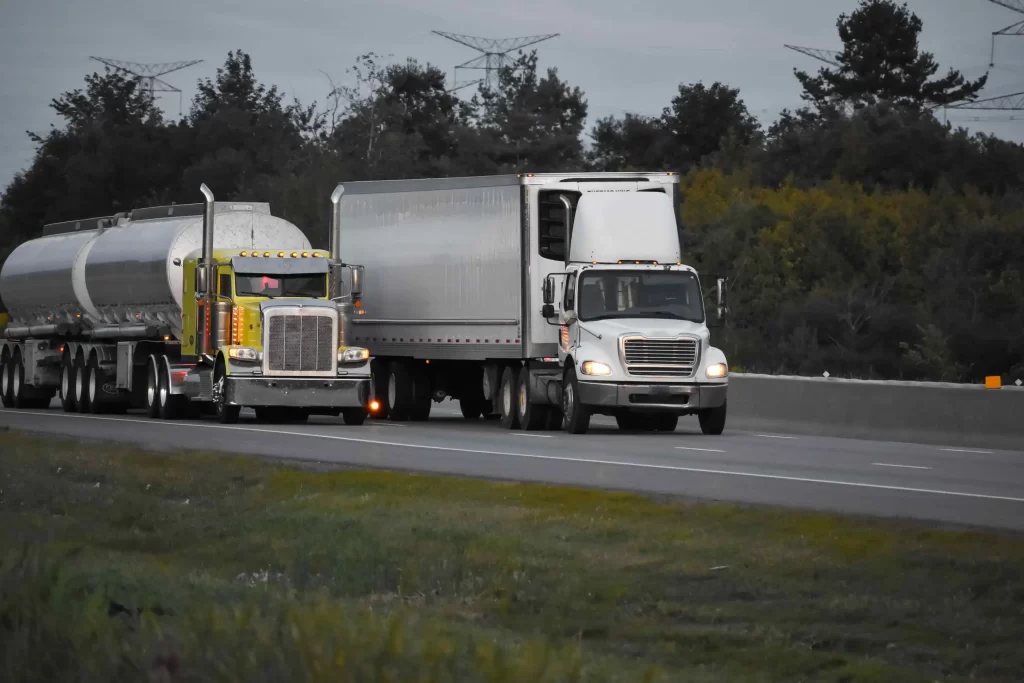A delivery van idles outside a client site for 18 minutes while the driver hunts for a loading-dock code. By the time he’s rolling again, the engine has drunk 0.3 gal of diesel and spewed out enough CO₂ to fill a shipping pallet.
That’s what we call idle time. Your vehicles’ engines keep running, wheels not turning, money evaporating. Even five extra minutes per vehicle, per shift, can bleed tens of thousands of dollars a year from a midsize fleet.
So, what is idle time? Why does it matter in fleets? We break these two key questions and dive even deeper into why idle time happens, how to spot it in your GPS data, and the playbook Traxxis clients use to crush those losses. So keep reading.
What is Idle Time?
When a vehicle is parked but the engine is still running, it is considered idle. This often happens when there are traffic jams or red lights. This results in the engine using fuel pointlessly, leading to wasted time, increased expenses, and harming the environment.
While some idle time is unavoidable, excessive idle time results in additional costs and pollution. Tackling idle time not only saves money and extends engine life, but also helps make the world a cleaner, greener place.
Impact of Idle Time
Idle time has a big impact on how vehicles run and what they cost. When vehicles sit idle, they burn fuel without moving, usually about 1 gallon per hour. So, if a delivery truck sits still for half an hour, it wastes resources, specifically about half a gallon of fuel.
Let’s do some quick math:
1 truck × 30 min idle × 260 workdays = 130 hrs/yr
At $3.17/gal:
130 hrs × 1 gal/hr × $3.17 / gal = $412 per truck
25-truck fleet → $10,300 in pure vaporised dieselAt $3.74/gal:
130 hrs × 1 gal/hr × $3.74 / gal = $486 per truck
25-truck fleet → $12,150 in pure vaporised diesel
And that’s before you count extra oil changes, DPF regens, or customer late-fees.
Also, idling for too long wears down engine parts faster, meaning more repairs and more costs. For instance, a taxi fleet that idles a lot might need more spark plug changes and engine fixes. Plus, unproductive time spent idling makes vehicles less fuel-efficient.
Engines work best when moving, so when they idle a lot, they use up more gas. This can make a big dent in a vehicle’s miles per gallon rating, like when a commuter car is stuck in traffic for ages. On top of that, too much idle time messes with operations and can lead to missed deadlines, decreasing business productivity by reducing time available for productive work. If a delivery van idles too much at stops, it can mess up deliveries and make customers unhappy.
And if your fleet is ready to turn those wasted minutes into measurable savings, Traxxis GPS Solutions can help you spot, track, and eliminate idle time before it eats into your margins.
Causes of Idle Time

1) A Fleet Driver Waiting on Traffic
Downtime occurs on vehicles for several reasons, regardless of their operational readiness. Idle time can result from both manageable and unforeseeable factors. Examples include employees’ waiting time and external influences such as supply chain disruptions or adverse weather.
It’s crucial to recognize and resolve these issues, including those related to human resources, to reduce idle time, enhance fleet efficiency, and mitigate financial losses, promoting streamlined operations.
2) Management Mistakes and Administrative Failures
When planning and decision-making go south, it can eat up precious time. Imagine a new manager of your fleet not being aware of how much time employees are idling in the yard or parking lot before leaving or starting their day. If managers are not aware or informed of this activity due to broken communication lines, this could lead to poor planning, causing increased costs, less production, and overtime headaches.
3) Market Dynamics
Ever seen a business hit the brakes because a new player joined the game? That’s what happens when market dynamics shift unexpectedly. Sometimes, demand dips, and companies have to pump the brakes on production. Other times, things like employee strikes or economic challenges, like the COVID-19 supply-chain crunch, throw a wrench in the works.
4) Ineffective Onboarding
Poor onboarding processes often escape notice as factors behind idle time. When onboarding lacks organization, it hampers productivity as new staff grapples with company protocols and standard operating procedures (SOPs). Idle time throughout the day or week can help managers pinpoint these inefficient workflows, these delays, and get to the root cause quickly. Acknowledging the significance of streamlined onboarding is crucial for reducing idle time in the field and enabling new hires to quickly integrate into the team, thereby enhancing their contributions to the organization.
5) Unexpected Personal Events or Issues
Stress or health-related employee absences can significantly contribute to idle time at work. When staff members are unable to work due to personal issues, it disrupts and even causes lost productivity and workflow, especially in the manufacturing facilities. These gaps in the workforce can cause delays in completing tasks and impact team performance. It’s essential to address the underlying causes of absenteeism to reduce idle time and ensure smooth operations.
6) Natural Tragedies
Weather disturbances can affect industries like transportation, mining, and shipping. Delays in the supply chain, arrival of raw materials, and power outages can occur from natural disasters that stop operations. Teams are often left waiting out storms, leading to decreased productivity. Travel delays exacerbate the situation, affecting multiple organizations within the supply chain.
Types of Idle Time
1) Normal Idle Time
This example of idle time is beyond management’s control and involves planned downtimes for preventive maintenance (PM) activities.
These tasks are essential practices required to sustain business operations. While they may seem unproductive, those considered normal idle time are crucial for maintaining equipment functionality and ensuring the continuity of business processes.
2) Abnormal Idle Time
This scenario falls entirely outside of management’s jurisdiction. It encompasses factors like employee strikes and disruptions in production supplies. While these issues may disrupt operations, they are beyond the realm of managerial influence and require adaptive strategies to mitigate their impact on productivity.
3) Planned Idle Time
Planned idle time refers to scheduled periods of inactivity within the production process. These intervals are deliberately built into the operational schedule to accommodate routine maintenance, machine waiting time, equipment calibration, or setup for subsequent production runs.
Unlike unplanned downtime, which can disrupt workflow unexpectedly, planned idle time is already included in the planned maintenance and strategically incorporated into the production process to guarantee optimal efficiency and minimize the risk of equipment failure or malfunction.
4) Unplanned Idle Time
Unplanned idle time occurs when production unexpectedly slows down, distinct from planned breaks for maintenance tasks or setup. It arises from surprises like faulty equipment and breakdowns, low supplies, or staffing issues, disrupting workflow and hindering production targets, which raises costs. Reduce idle time by identifying and addressing its causes. This is crucial for maintaining smooth production operations.
Idle Time Formula Overview
Here’s how to compute for your idle time:
| What you want to measure | Formula | What it tells you |
|---|---|---|
| Idle Time (hours) | Idle Time = Scheduled Run Time − Actual Run Time | The raw hours (or minutes) lost to idling or downtime. |
| Idle Time % | Idle % = (Idle Time ÷ Scheduled Run Time) × 100 | The share of the planned shift that wasn’t productive. |
| Idle Fuel Cost | Idle Fuel Cost = Idle Time × Fuel-Burn Rate × Fuel Price | The dollars blown while the engine ran but the wheels didn’t move. |
| Idle Maintenance Cost (optional) | Idle Time × (Extra PM Cost per Idle Hour) | A proxy for wear-and-tear expenses driven by excessive idling. |
How it works in practice
Example (single truck, one shift)
- Scheduled run time: 8 h
- Actual productive time: 6.25 h
- Idle time: 8 − 6.25 = 1.75 h
- Idle %: (1.75 ÷ 8) × 100 = 21.9 %
- Fuel burn rate while idling: 0.9 gal/h
- Diesel price: AU $2.10/gal
Idle fuel cost for the shift:
1.75 h × 0.9 gal/h × AU $2.10 = AU $3.31
Multiply that by 260 workdays and a 30-vehicle fleet and you’re looking at ~AU $25 800 a year—money literally evaporating out of the tailpipe.
Tip: Track Idle % by vehicle and by driver. Anything over 10–15 % is often easy, quick-win savings once you introduce real-time alerts and coaching.
What’s the Solution?

The first step in eliminating idle-time losses isn’t lecturing drivers—or even changing routes. It’s measuring the problem in real time. Once you can see exactly when, where, and how long each engine sits running, the savings opportunities jump off the screen.
That’s why fleets start with a GPS-based tracking platform:
- Live engine-status feeds flag the moment a vehicle crosses your idle threshold (e.g., three minutes).
- Automated alerts nudge drivers to shut down or move on.
- Dashboards and scorecards rank vehicles, routes, and drivers by idle percentage and fuel dollars lost.
- Historical reports show whether coaching and rule changes are actually working.
Traxxis’ GPS Solutions is purpose-built for this job. Alongside standard location tracking, we layers on:
- Instant in-cab alerts for excessive idle events
- Customisable driver and vehicle idle scorecards
- Fleet-wide fuel and CO₂ reports you can drop straight into ESG filings
Our solutions aren’t the only way to track idle time, but they bundle the sensors, software, and support into a single, ready-to-deploy package, so fleets can go from zero visibility to data-driven savings in days, not months.
And if you’d rather skip the trial-and-error phase, our team can set you up with a complete idle-time monitoring system. Get in touch with us today if you want to make that happen for your business.
Key Benefits of Tracking that Address Idle Time’s Main Concerns
Leveraging GPS tracking software to address idle time can give your business real benefits. Here’s a look at a few key advantages:
1) Improved Fuel Efficiency
Fuel costs are a big part of fleet expenses; whenever an engine is idling, it will cost you money. You can cut fuel expenses by up to 14%. Its advanced features enable businesses to enhance travel and logistics, leading to significant cost reductions with Traxxis.
Tracking idle time helps you address inefficiencies in driver behavior and route selection, minimizing unnecessary fuel consumption. Without this technology, operations along the production line may suffer from fuel wastage due to various inefficiencies.
2) Reduced Maintenance Costs
Accurately calculating idle time results in better preventative maintenance schedules for their fleet vehicles. This proactive approach guarantees that maintenance schedules are based on actual engine usage rather than just mileage, which also leads to fewer unexpected breakdowns and lower repair expenses.
Competitors using GPS technology gain a significant edge by maximizing vehicle uptime and minimizing maintenance-related downtime.
3) Business Decisions
These include selecting the appropriate GPS tracking system tailored to monitor idle time effectively and deciding on the implementation strategy for integrating it into existing production processes. They need to determine how to utilize the collected data to optimize fleet management and reduce idle time, while also providing employee training on GPS tracking systems usage and their impact on production processes.
Clear policies and guidelines must be established regarding GPS tracking usage and consequences for excessive idle time, alongside establishing metrics and benchmarks for performance evaluation to measure the technology’s effectiveness in reducing idle time and enhancing fleet efficiency.
Impact on Productivity

Trucks driving smoothly with proper planning making your workers productive while on the job.
Excessive idle time significantly impacts profitability, primarily through fuel wastage and lost time in the field. It impacts a company’s competitive edge, particularly for those operating extensive fleets. As per the North American Council for Freight Efficiency, idling can consume between 0.6 to 1 gallon of fuel every hour.
Vehicle battery-powered air heaters alone can use a gallon of fuel daily. The council’s report emphasizes the need for fleets to utilize a combination of technologies, highlighting the crucial role of drivers in successfully managing idle times. Accurately tracking idle time is essential for implementing effective solutions and optimizing fleet performance.
If you want to see how your fleet stacks up, Traxxis GPS Solutions offers a free idle-time audit that will give you a clear picture of where your biggest opportunities for savings lie. Book a demo with us.
Final Wrap-Up
Most fleet operators assume that idle engines just burn fuel, and that’s fine. But ultimately, they burn profit, reputation, and your window to hit sustainability targets.
Cutting those wasted minutes is one of the fastest, least‐disruptive ways to lift fleet margins: a two-minute reduction per vehicle, per shift can translate into thousands in annual savings, fewer emergency repairs, and a measurable drop in CO₂.
If you can measure it, you can fix it— and Traxxis puts that measurement on a live dashboard your team can act on tomorrow.
Are you ready to turn idle time into extra uptime? Talk to our fleet-efficiency specialists at Traxxis GPS Solutions. We’ll analyse a week of your engine-runtime data, pinpoint the biggest leakage points, and map out a step-by-step plan to slash idle minutes across your entire fleet.
→ Book your audit now and start saving on your very next fuel cycle.
Frequently Asked Questions
How Can Companies Effectively Minimize Idle Time?
To effectively minimize idle time, companies can implement various strategies. Utilizing advanced GPS tracking technology allows for accurate monitoring and analysis of idle time patterns, pinpointing root causes such as machine downtime. By establishing preventive maintenance schedules and addressing potential issues proactively, companies can minimize unplanned idle time. Optimizing workflow processes, scheduling tasks efficiently, and providing ongoing training to employees are also vital in reducing idle time and maximizing productivity.
What Are Some Common Tools Used To Track Idle Time?
Popular tools for tracking idle time include GPS tracking systems, which monitor vehicle movement and engine activity, offering real-time insights into idle periods. Telematics solutions provide data on engine usage, fuel consumption, and machine downtime, aiding in identifying idle time trends. Time-tracking software logs employee activities, pinpointing unproductive periods. Moreover, computerized maintenance management systems track machine idle time, enabling proactive maintenance scheduling for maintenance teams to reduce idle time and enhance operational efficiency.
How Does Idle Time Impact Operating Costs?
Think about it like when your vehicle’s engine is on but you’re not going anywhere. It’s burning fuel for nothing! Plus, all that idling wears down your ride faster. And when your team’s not hustling, you’re still shelling out for their time, but the work output takes a hit. To keep costs in check on a construction site, we have to find ways to cut idle time, make smarter moves with what we’ve got, and just run a tighter ship overall.
Can Idle Time Be Completely Eliminated?
While it may not be feasible to entirely eradicate idle time, companies can notably diminish it by employing effective management techniques. Utilizing strategies such as streamlining workflow processes, instituting proactive maintenance schedules, and harnessing technology solutions like GPS tracking systems can effectively curb idle time. These approaches empower businesses to optimize resource utilization and enhance operational efficiency, leading to reduced idle periods and improved productivity. Promoting employee awareness and accountability regarding idle time can further contribute to its reduction. While complete elimination may be challenging, cyclical fluctuations can be managed with proactive measures that can substantially mitigate idle time’s impact on operational efficiency and costs.
How can I measure the impact of idle time reduction in GPS tracking?
Businesses can measure the impact of idle time reduction efforts by analyzing key performance indicators such as fuel consumption rates, maintenance expenses, vehicle utilization rates, and overall fleet productivity. Comparing data before and after implementing idle time reduction strategies can provide valuable insights into their effectiveness.
How can I minimize idle time?
To minimize idle time, businesses can implement several strategies. These include optimizing workflow processes to ensure efficient task completion, scheduling preventive maintenance to minimize equipment downtime, and leveraging technology solutions like GPS tracking systems to monitor and address idle periods. Additionally, providing proper training to employees on productivity best practices and encouraging proactive communication can help identify and mitigate factors contributing to idle time, thereby improving overall operational efficiency.





